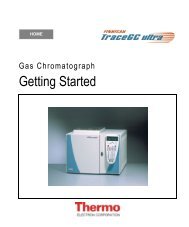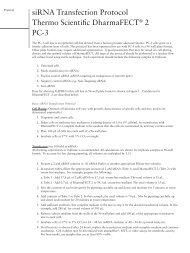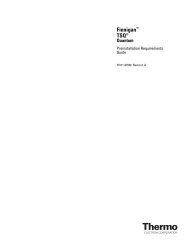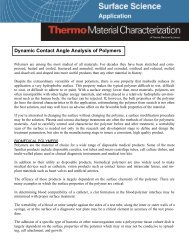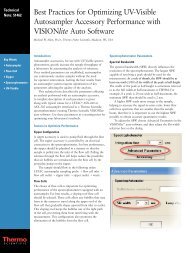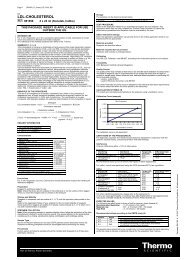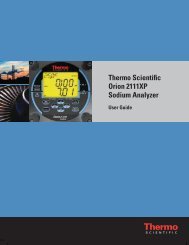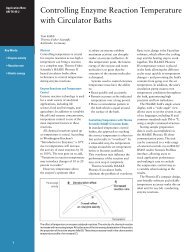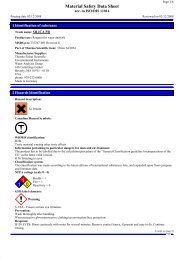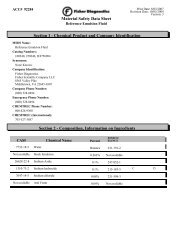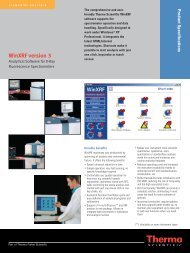pGIPZ Manual - Thermo Scientific
pGIPZ Manual - Thermo Scientific
pGIPZ Manual - Thermo Scientific
You also want an ePaper? Increase the reach of your titles
YUMPU automatically turns print PDFs into web optimized ePapers that Google loves.
Expression Arrest GIPZ lentiviral shRNAmirCONTENTSTopicPageProduct Description 1Design Information 1Vector Information 2Vector Map- <strong>pGIPZ</strong> 4Antibiotic Resistance 4Quality Control 5Protocol I - Replication 6Protocol II - Plasmid Preparation 7Protocol III - Cloning 7Protocol IV - Restriction Digest 12Protocol V - Puromycin Selection 12Protocol VI - Transfection 13Protocol VII - Packaging 17Protocol VIII - Titering 17Protocol IX - Transduction 21Protocol X - QPCR 22Controls and Validation 23Related Reagents 26FAQS 26Troubleshooting 28References 29Licensing Information 30Important Safety Note:Follow NIH guidelines regarding lentiviral production and transduction; follow Biosafety Level 2 (BL2) or BL2+laboratory criteria.NIH Agent Summary Statement: http://bmbl.od.nih.gov/viral2.htm#retroNIH Biosafety Level 2 Description: http://bmbl.od.nih.gov/sect3bsl2.htmNIH/RAC “Guidance on Biosafety Considerations for Research with Lentiviral Vectors”:http://www4.od.nih.gov/oba/RAC/Guidance/LentiVirus_Containment/pdf/Lenti_Containment_Guidance.pdfPlease note that GIPZ vectors are not compatible with third generation packaging systems suchas ViraPower from Invitrogen. We recommend the Trans-Lentiviral Packaging system for use withour vectors.PRODUCT DESCRIPTIONThe GIPZ lentiviral shRNAmir library was developed by Open Biosystems in collaboration withDr. Greg Hannon (CSHL) and Dr. Steve Elledge (Harvard). This library combines the designadvantages of microRNA-adapted shRNA (shRNAmir) with the <strong>pGIPZ</strong> lentiviral vector to createa powerful RNAi trigger capable of producing RNAi in most cell types including primary and nondividingcells.DESIGN INFORMATIONUnique microRNA-30 based hairpin designExpression Arrest short hairpin RNA constructs are expressed as human microRNA-30(miR30) primary transcripts (Figure 1). This design adds a Drosha processing site to the hairpinconstruct and has been shown to greatly increase knockdown efficiency (Boden, Pusch et al.2004). The hairpin stem consists of 22nt of dsRNA and a 19nt loop from human miR30. Addingthe miR30 loop and 125nt of miR30 flanking sequence on either side of the hairpin results inTechnical support: 1-888-412-2225 Page 1Fax: 1-256-704-4849info@openbiosystems.comPB081808For Research Use Only
greater than 10-fold increase in Drosha and Dicer processing of the expressed hairpins whencompared with conventional shRNA designs without microRNA (Silva, Li et al. 2005). IncreasedDrosha and Dicer processing translates into greater siRNA/miRNA production and greaterpotency for expressed hairpins.Figure 1. Expression Arrest shRNA are expressed as miR30primary transcriptsUse of the miR30 design also allowed the use of 'rules-based' designs for target sequenceselection. One such rule is the destabilizing of the 5' end of the antisense strand which resultsin strand specific incorporation of miRNAs into RISC.The proprietary design algorithm targets sequences in coding regions and the 3’UTR with theadditional requirement that they contain greater than 3 mismatches to any other sequence in thehuman or mouse genomes.Each shRNA construct has been sequence verified to ensure a match to the target gene. Toassure you the highest possibility of modulating the gene expression level, each gene isrepresented by multiple shRNA constructs, each covering a unique region of the target gene.VECTOR INFORMATIONVersatile vector designFeatures of the <strong>pGIPZ</strong> lentiviral vector (Figure 2-3, Table 1) that make it a versatile tool forRNAi studies include:• Ability to perform transfections or transductions using the replication incompetentlentivirus (Shimada, et al. 1995)• TurboGFP and shRNAmir are part of a bicistronic transcript allowing the visual markingof shRNAmir expressing cells• Amenable to in vitro and in vivo applications• Puromycin drug resistance marker for selecting stable cell lines• Molecular barcodes enable multiplexed screening in poolsTechnical support: 1-888-412-2225 Page 2Fax: 1-256-704-4849info@openbiosystems.comPB081808For Research Use Only
Figure 2: <strong>pGIPZ</strong> lentiviral vectorTable 1. Features of the <strong>pGIPZ</strong> vectorVector ElementUtilityCMV PromoterRNA Polymerase II promotercPPTCentral Polypurine tract helps translocation into the nucleus of non-dividing cellsWREEnhances the stability and translation of transcriptsTurboGFPMarker to track shRNAmir expressionIRES-puro resistance Mammalian selectable markerAmp resistanceAmpicillin (carbenicillin) bacterial selectable marker5'LTR5' long terminal repeatpUC oriHigh copy replication and maintenance of plasmid in E. coliSIN-LTR 3' Self inactivating long terminal repeat (Shimada, et al. 1995)RRERev response elementZeo resistanceBacterial selectable markerTechnical support: 1-888-412-2225 Page 3Fax: 1-256-704-4849info@openbiosystems.comPB081808For Research Use Only
VECTOR MAPFigure 3. Detailed vector map of <strong>pGIPZ</strong> lentiviral vector.ANTIBIOTIC RESISTANCE<strong>pGIPZ</strong> TM contains 3 antibiotic resistance markers (Table 2).Table 2. Antibiotic resistances conveyed by <strong>pGIPZ</strong>Antibiotic Concentration UtilityAmpicillin (carbenicillin) 100μg/ml Bacterial selection marker (outside LTRs)Zeocin 25μg/ml Bacterial selection marker (inside LTRs)Puromycin variable Mammalian selectable markerTechnical support: 1-888-412-2225 Page 4Fax: 1-256-704-4849info@openbiosystems.comPB081808For Research Use Only
QUALITY CONTROLThe GIPZ lentiviral shRNAmir library has passed through internal QC processes to ensure highquality and low recombination (Figures 4 and 5).Figure 4. Representative shRNAmir containing <strong>pGIPZ</strong> lentiviral clones grown for 16 hours at 30°C and the plasmidisolated and normalized to a standard concentration. Clones were then digested with SacII and run out on a gel. Theexpected band sizes are 1259bp, 2502bp, 7927bp. No recombinant products are visible. 10kb molecular weightladder (10kb, 7kb, 5kb, 4kb, 3kb, 2.5kb, 2kb, 1.5kb, 1kb)4Figure 5. Gel image of a single plate from the GIPZ library cultured for 10 successive generations in anattempt to determine the tendency of the <strong>pGIPZ</strong> vector to recombine. Each generation was thawed,replicated and incubated overnight for 16 hours at 30°C then frozen, thawed and replicated. This processwas repeated for 10 growth cycles. After the 10th growth cycle, plasmid was isolated and normalized to astandard concentration. Clones were then digested with SacII and run on a gel. Expected band sizes1259bp, 2502bp, 7927bp. 10kb molecular weight ladder (10kb, 7kb, 5kb, 4kb, 3kb, 2.5kb, 2kb, 1.5kb,1kb).The <strong>pGIPZ</strong> vector appears stable without showing any recombination.Technical support: 1-888-412-2225 Page 5Fax: 1-256-704-4849info@openbiosystems.comPB081808For Research Use Only
PROTOCOL I - REPLICATIONTable 3. Materials for plate replicationItem Vendor Catalog NumberLB-Lennox broth (low salt) VWR EM1.00547.0500Peptone, granulated, 2kg - Difco VWR 90000-368Yeast Extract, 500g, granulated VWR EM1.03753.0500NaCl Sigma S-3014Glycerol VWR EM-2200 or 80030-956Carbenicillin or ampicillin Novagen 69101-3Zeocin Invivogen ant-zn-5pPuromycin Cellgro 61-385-RA96 well microplates Nunc 260860Aluminum seals Nunc 276014Disposable replicators Genetix X5054Disposable replicators Scinomix SCI-5010-OSFor archive replication, grow all <strong>pGIPZ</strong> clones at 30°C in LB-Lennox (low salt) media plus25μg/ml zeocin and 100μg/ml carbenicillin in order to provide maximum stability of the clones.Prepare media with 8% glycerol* and the appropriate antibiotics.Replication of platesPrepare target plates by dispensing ~160μl of LB-Lennox (low salt) media supplemented with8% glycerol* and appropriate antibiotic (25μg/ml zeocin and 100μg/ml carbenicillin).Prepare source plates:1. Remove foil seals while the source plates are still frozen. This minimizes crosscontamination.2. Thaw the source plates with the lid on. Wipe any condensation underneath the lid with apaper wipe soaked in ethanol.Replicate:1. Gently place a disposable replicator in the thawed source plate and lightly move thereplicator around inside the well to mix the culture. Make sure to scrape the bottom of thewell.2. Gently remove the replicator from the source plate and gently place in the target plate andmix in the same manner to transfer cells.3. Dispose of the replicator.4. Place the lids back on the source plates and target plates.5. Repeat steps 1-4 until all plates have been replicated.6. Return the source plates to the -80°C freezer.7. Place the inoculated target plates in a 30°C incubator without shaking for 18-19 hours.Freeze at -80°C for long term storage. Avoid long periods of storage at room temperature orhigher in order to control background recombination products.Note: Due to the tendency of all viral vectors to recombine, we recommend keeping theincubation times as short as possible and avoid subculturing.*Glycerol can be omitted from the media if you are culturing for plasmid preparation. If makingcopies of the constructs for long term storage at -80°C, 8% glycerol is required.Technical support: 1-888-412-2225 Page 6Fax: 1-256-704-4849info@openbiosystems.comPB081808For Research Use Only
PROTOCOL II - PLASMID PREPARATIONCulture conditions for individual plasmid preparationsFor plasmid preparation, grow all <strong>pGIPZ</strong> clones at 37°C in 2X-LB broth (low salt) media plus100μg/ml carbenicillin only.2X-LB broth (low salt) media preparationLB-Broth-Lennox20g/lPeptone10g/lYeast Extract5g/lAppropriate antibiotic(s) at recommended concentration(s)Most plasmid mini-prep kits recommend a culture volume of 1-10ml for good yield.For shRNAmir constructs, 5ml of culture can be used for one plasmid mini-prep generallyproducing 5-10µg of plasmid DNA.1. Upon receiving your glycerol stock(s) containing the shRNAmir of interest store at -80°Cuntil ready to begin.2. To prepare plasmid DNA first thaw your glycerol stock culture and pulse vortex to resuspendany E. coli that may have settled to the bottom of the tube.3. Take a 10μl inoculum from the glycerol stock into 3-5ml of 2X-LB (low salt) with 100μg/mlcarbenicillin. Return the glycerol stock(s) to -80°C.Note: If a larger culture volume is desired, incubate the 3-5ml culture for 8 hours at37ْC with shaking and use as a starter inoculum. Dilute the starter culture 1:500-1:1000 into the larger volume.4. Incubate at 37°C for 18-19 hours with vigorous shaking.5. Pellet the 3-5ml culture and begin preparation of plasmid DNA.6. Run 3-5μl of the plasmid DNA on a 1% agarose gel. <strong>pGIPZ</strong> with shRNAmir is 11774bp.Note: Due to the tendency of all viral vectors to recombine, we recommend keeping theincubation times as short as possible and avoid subculturing. Return to your original glycerolstock for each plasmid preparation.Culture conditions for 96 well bio-block plasmid preparationInoculate a 96 well bio-block containing 1ml per well of 2X-LB (low salt) media with 100μg/mlcarbenicillin with 1µl of the culture. Incubate at 37°C with shaking (~170-200rpm). We haveobserved that incubation times between 18-19 hours produce good plasmid yield. For plasmidpreparation, follow the protocols recommended by the plasmid isolation kit manufacturer.Note: Open Biosystems uses the above 96 well bio-block plasmid preparation protocol inconjunction with a Qiagen Turbo kit (catalog no. 27191). We use 2 bio-blocks combined, do notperform the optional wash and elute the DNA in water.PROTOCOL III - CLONINGMoving shRNAmir constructs from pSM2 to <strong>pGIPZ</strong>1. Order the pSM2 vector already expressing the shRNAmir of interest from Open Biosystems.Technical support: 1-888-412-2225 Page 7Fax: 1-256-704-4849info@openbiosystems.comPB081808For Research Use Only
2. Order the following PCR primers:pSM2 forward - 5' aagccctttgtacaccctaagcct 3'pSM2 reverse - 5' actggtgaaactcacccagggatt 3'3. Order a KOD Hotstart Polymerase kit from Novagen (catalog no. 71086-5 for 20U)4. Resuspend the PCR primers at a stock concentration of 50pmol/μl in sterile DEPC water.Dilute the stock 1:10 for a working concentration of 5pmol/μl in sterile DEPC water.5. Set up the following PCR reaction at room temperature (Table 4). Add the components inthe order listed. The following is for one 50ul reaction. To do more reactions simply multiplythe master mix components by the desired number of reactions plus 10%. We recommenddoing 4 reactions to ensure enough fragment will be available for cloning.Table 4. PCR reactionComponentvolume in μlH20 (DEPC) 255M Betaine 510X PCR buffer for KOD Hotstart Polymerase 5dNTP's (2mM each) 5MgSO4 25mM 2pSM2 Forward Primer (5pmol/μl) 3pSM2 Reverse Primer (5pmol/μl) 3KOD Hotstart Polymerase (1U) 1Total volume 49Template (1ul of glycerol stock from your pSM2 1clone of interest)6. Input the following program into your thermocycler (Table 5):Table 5. PCR programPCR Program HS KODTemperatureTimeHot Start Enzyme Activation 94˚C 2minMelt 94˚C 15secAnneal 58˚C 30secExtension 72˚C 25secCycles30˚CExpected Product Size1735bp7. Put the four PCR reactions through a Wizard SV Gel and PCR Clean-up System columnaccording to the kit directions (Promega catalog no. A9281 for 50 preps), with the exceptionof eluting with 110μl of the provided nuclease free water. All four reactions can be run on asingle SV Gel and PCR Clean-up column.8. Set up the following restriction digest using the Clean-up column eluent (Table 6) andIncubate at 37˚C for 3 hours.Technical support: 1-888-412-2225 Page 8Fax: 1-256-704-4849info@openbiosystems.comPB081808For Research Use Only
Table 6. Restriction digestComponentvolume in μlPCR elutent 10010X Restriction Enzyme Buffer 20MluI 2XhoI 2Sterile Water 76Total volume 2009. Run the entire digest on a 1.2%-1.5% agarose gel. Three bands should be seen (789bp,683bp, and 345bp) (Figures 6 and 7). Three bands will appear only if both MluI and XhoIhave cut. Therefore the digest is diagnostic of the enzyme cuts in the following fashion(Table 7).PCR product diagramXhoIFigure 6. PCR product diagramMluI789bp 345bp 683bp345bp bandcontaining theshRNAmirFigure 7. MluI and XhoI digest of PCR elutent with the expected digestionpattern (789bp, 683bp, 345bp)Table 7. Possible digestion patternsBand sizes seen1735bp only789bp, 683bp, and 345bp1028bp and 789bp1134bp and 683bpConclusionNeither MluI or XhoI cutBoth MluI and XhoI cutOnly XhoI cut. MluI did not cut.Only MluI cut. XhoI did not cut.10. Excise the 345bp band containing the shRNAmir of interest and purify on a Wizard SV Geland PCR Clean-up System column according to the kit directions (Promega catalog no.A9281 for 50 preps). Elute in 50μl nuclease free water.11. Quantitate the insert fragment.12. Prepare the <strong>pGIPZ</strong> empty vector for ligation to the shRNAmir insert. Set up the followingrestriction digest (Table 8).Technical support: 1-888-412-2225 Page 9Fax: 1-256-704-4849info@openbiosystems.comPB081808For Research Use Only
Table 8. Restriction digestComponentvolume in μl<strong>pGIPZ</strong> empty vector (250ng/μl) 1210X Restriction Enzyme Buffer 10MluI 2XhoI 2Sterile Water 74Total volume 10013. Mix the solution by pipetting and then gently spin the reaction for approximately 10 secondsto collect all the solution in the bottom of the tube. This will aid in decreasing contaminationof uncut vector in your vector prep to follow. Incubate at 37˚C for 3 hours.14. Run the entire digest on a 0.8% agarose gel. Make sure to run the gel through no less than3cm length of agarose. This will also aid in decreasing contamination of uncut vector in yourvector prep.15. Gel isolate the 11429bp band using a Wizard SV Gel and PCR Clean-up System columnaccording to the kit directions (Promega catalog no. A9281 for 50 preps). Elute in 50μlnuclease free water. You will likely not see a band representing the excised portion of thevector as it is too small (~259bp).16. Quantitate the amount of cut vector per μl you have isolated.17. Set up the following ligation reactions (Table 9):Table 9. Ligation reactionsComponent No Insert control shRNAmir ligationshRNAmir insert cut with MluI and XhoI (total 7.4ng) XXXXXXXXX ____ μl<strong>pGIPZ</strong> vector cut with MluI and XhoI (total 250ng) ____ μl ____ μlDEPC water ____ μl ____ μl10X ligase buffer 2 μl 2 μlLigase 0.5 μl 0.5 μlTotal volume 20 μl 20 μlNote: This setup yields a molar ratio of 1 vector to 1 insert.18. Ligate for 3 hours at room temperature. Dilute the ligation mix by adding 160μl DEPC water.19. Transform 5μl of the diluted ligation mix into PrimePlus TM competent E.coli (OpenBiosystems catalog no. MBC4246). Follow the transformation protocol for the competentcells. Plate the transformed cells onto agar plates containing 100μg/ml carbenicillin and25μg/ml zeocin. Be sure to transform the same volume of ligation mix and plate the samevolume of cells for both the control and the experimental sample. Plating 100μl, 50μl, and10μl aliquots is recommended.20. Incubate plates at 30˚C overnight. Count colonies and determine the ratio of colonies on thecontrol plate versus the experimental plates. Determine the number of colonies to screen.Technical support: 1-888-412-2225 Page 10Fax: 1-256-704-4849info@openbiosystems.comPB081808For Research Use Only
21. Order the following PCR primers to screen your clones for insertion of the shRNAmirsequence of interest.X76 Forward - 5' acgtcgaggtgcccgaagga -3'M100 Reverse - 5' aagcagcgtatccacatagcgt -3'22. Set up the following PCR reaction (Table 10). For template simply pick a colony with atoothpick, swirl in a small broth culture containing ampicillin and zeocin to maintain a stockand then swirl the same toothpick into your PCR well containing the appropriate amount ofmaster mix. For a no insert control simply use 1ng of empty <strong>pGIPZ</strong> TM vector. The amounts inthe table below are for a single 50μl reaction.Table 10. PCR reactionComponentvolume in μlH20 (DEPC) 265M Betaine 510X PCR buffer for KOD Hotstart Polymerase 5dNTP's (2mM each) 5MgSO 4 25mM 2X76 Forward Primer (5pmol/μl) 3M100 Reverse Primer (5pmol/μl) 3KOD Hotstart Polymerase (1U) 1Total volume 49Template colony picked with toothpick ---23. Run the following PCR program (Table 11). Note the annealing temperature has changed.Table 11. PCR programPCR Program HS KOD#2TemperatureTimeHot Start Enzyme Activation 94˚C 2minMelt 94˚C 15secAnneal 56˚C 30secExtension 72˚C 25secCycles 3024. Expected band sizes are as follows:shRNA inserted = 603bp (clone with barcode); 543bp (clone without barcode)No shRNA inserted = 516bp25. Sequence verify clones. The <strong>pGIPZ</strong> sequencing primer is as follows:5’- GCATTAAAGCAGCGTATC -3’Note: The binding site lies from base 5820-5842 and runs in the reversecomplement direction. The melting temperature of this 18mer=52.7°C.Technical support: 1-888-412-2225 Page 11Fax: 1-256-704-4849info@openbiosystems.comPB081808For Research Use Only
PROTOCOL IV - RESTRICTION DIGESTThe following is a sample protocol for restriction enzyme digestion using KpnI, SacII, SalI, XhoIand/or NotI for diagnostic quality control of GIPZ lentiviral vectors.1. Using filtered pipette tips and sterile conditions add the following components (Table 12), inthe order stated, to a sterile PCR thin-wall tube.Table 12. PCR ComponentsComponentAmountSterile, nuclease-free waterXµlRestriction enzyme 10X buffer 1µlBSA (10X, 10mg/ml) if required 1µlDNA sample 80-240ng, in water or TE bufferXµlRestriction enzyme 20U0.25µlFinal volume 10µl2. Mix gently by pipetting.3. Incubate in a thermalcycler at 37°C for 2 hours to digest4. Load the gel with 10µl of each of the digested samples (KpnI, SacII, SalI, XhoI and/or NotI)on a 1% agarose gel. Run uncut sample alongside the digested samples. (Figure 8)Figure 8. Restriction digests with <strong>pGIPZ</strong>. Lane 1- 10kb molecular weight ladder (10kb, 7kb, 5kb, 4kb,3kb, 2.5kb, 2kb, 1.5kb, 1kb). Lane 2 - Uncut <strong>pGIPZ</strong> vector. Lane 3 - KpnI digested <strong>pGIPZ</strong> produces 2bands at 1750bp and 9860bp. Lane 4- SacII digest produces 3 bands at 1178bp, 2502bp and 7930bp.Lane 5 -SalI produces 3 bands at 2188bp, 4298bp and 5124bp. Lane 6 - XhoI, NotI double digestproduces 2 bands at 1210bp and 10400bp.PROTOCOL V - PUROMYCIN SELECTIONPuromycin Kill Curve and Puromycin SelectionIn order to generate stable cell lines, it is important to determine the minimum amount ofpuromycin required to kill non-transfected/transduced cells. This can be done by generating apuromycin kill curve.Technical support: 1-888-412-2225 Page 12Fax: 1-256-704-4849info@openbiosystems.comPB081808For Research Use Only
Puromycin Kill Curve1. On day 0 plate 5 x 10 4 cells per well in a 24 well plate in enough wells to carry out yourpuromycin dilutions. Incubate overnight.2. Prepare media specifically for your cells containing a range of antibiotic, for example: 0 -15μg/ml puromycin.3. The next day (day 1) replace the growth media with the media containing the dilutions of theantibiotic into the appropriate wells.4. Incubate at 37°C.5. Approximately every 2-3 days replace with freshly prepared selective media.6. Monitor the cells daily and observe the percentage of surviving cells. Optimum effectivenessshould be reached in 3-6 days under puromycin selection.7. The minimum antibiotic concentration to use is the lowest concentration that kills 100% ofthe cells in 3-6 days from the start of antibiotic selection.PROTOCOL VI - TRANSFECTIONThe protocol below is optimized for transfection of the shRNA plasmid DNA into HEK293T cellsin a 24 well plate using serum free media. If a different culture dish is used, adjust the numberof cells, volumes and reagent quantities in proportion to the change in surface area (Table 13).It is preferable that transfections be carried out in medium that is serum free and antibiotic free.A reduction in transfection efficiency occurs in the presence of serum, however it is possible tocarry out successful transfections with serum present (see Transfection Optimization).Warm Arrest-In to ambient temperature (approximately 20 minutes at room temperature) priorto use. Always mix well by vortex or inversion prior to use.Maintain sterile working conditions with the DNA and Arrest-In mixtures as they will be added tothe cells.Table 13. Suggested amounts of DNA, medium and Arrest-In reagent for transfection of shRNA plasmidDNA into adherent cells.Tissue CultureDishPlasmid DNA(μg)*Arrest-In (μg)**Surface areaper plate or well(cm2)Total serumfree mediavolume per well(ml)60 mm 20 2 4 2135 mm 8 1 2 106 well 9.4 1 2 1012 well 3.8 0.5 1 524 well 1.9 0.25 0.5 2.596 well 0.3 0.1 0.1 - 0.2 0.5 - 1*Recommended starting amount of DNA. May need to be optimized for the highest efficiency**Recommended starting amount of Arrest-In reagent. See Transfection Optimization.1. The day before transfection (day 0), plate the cells at a density of 5 x 10 4 cells per well of a24 well plate.Full medium (i.e. with serum and antibiotics) will be used at this stage.2. On the day of transfection form the DNA/Arrest-In transfection complexes.Technical support: 1-888-412-2225 Page 13Fax: 1-256-704-4849info@openbiosystems.comPB081808For Research Use Only
a. For each well to be transfected, dilute 500ng shRNA plasmid DNA into 50µl (totalvolume) of serum free medium in a microfuge tube.b. For each well to be transfected, dilute 2.5µg (2.5µl) of Arrest-In into 50µl (totalvolume) serum free medium into a separate microfuge tube.c. Add the diluted DNA (step a) to the diluted Arrest-In reagent (step b), mixrapidly then incubate for 20 minutes at room temperature.This will give a 1:5 DNA:Arrest-In ratio by mass which is recommended foroptimal transfection into HEK293T cells. Your total volume will be 100µl at thisstage.3. Aspirate the growth medium from the cells. Add an additional 150µl of serum free mediumto each of the tubes containing transfection complexes (100μl). Add the total volume of thetube (250µl) to the cells and incubate for 5-6 hours in a CO 2 incubator at 37 o C.Your total volume will be 250µl at this stage (150μl serum-free medium + 100μlDNA:Arrest-In mixture).4. Following the 5-6 hour incubation, add an equal volume of growth medium (250µl)containing twice the amount of normal serum to the cells (i.e. to bring the overallconcentration of serum to what is typical for your cell line). Alternatively, the transfectionmedium can be aspirated and replaced with the standard culture medium (see note).Return the cells to the CO 2 incubator at 37 o C.Note - Arrest-In has displayed low toxicity in the cell lines tested, thereforeremoval of transfection reagent is not required for many cell lines. In our handshigher transfection efficiencies have been achieved if the transfection medium isnot removed. However, if toxicity is a problem, aspirate the transfection mixtureafter 5-6 hours and replace with fresh growth medium. Additionally, fresh growthmedium should be replenished as required for continued cell growth.5. After 24-72 hours of incubation, examine the cells microscopically for the TurboGFPexpression.Note: When visualizing TurboGFP expression, if less than 90% of all cells aregreen, it is recommended in these cases to utilize puromycin selection in order toreduce background expression of your gene of interest from untransfected cells(see Figure 11).The working concentration of puromycin varies between cell lines. Werecommend you determine the optimal concentration of puromycin required to killyour host cell line prior to selection for shRNAmir transfectants (see puromycinkill curve protocol, page 20). Typically, the working concentration ranges from 1-10µg/ml. You should use the lowest concentration that kills 100% of the cells in1-4 days from the start of puromycin selection.Technical support: 1-888-412-2225 Page 14Fax: 1-256-704-4849info@openbiosystems.comPB081808For Research Use Only
abFigure 9. <strong>pGIPZ</strong> shRNAmir to GAPDH transfected into HEK293T cells 24 hours posttransfection. a) Phase b) TurboGFP fluorescence. Note the high percentage of cellssuccessfully transfected.abcdFigure 10. <strong>pGIPZ</strong> shRNAmir to GAPDH transfected into HEK293T cells 14 days posttransfection. a) Phase. No puromycin selection. b) TurboGFP fluorescence. Nopuromycin selection. c) Phase. Puromycin selected. d) TurboGFP fluorescence.Puromycin selected. Note the decrease in the number of cells expressing TurboGFPwhen puromycin selection is not applied. When puromycin selection is maintainedTurboGFP expression remains in all cells at high levels.a. If adding puromycin, use the appropriate concentration as determined based onthe above kill curve. Incubate.b. Approximately every 2-3 days replace with freshly prepared selective media.c. Monitor the cells daily and observe the percentage of surviving cells. At sometime point almost all of the cells surviving selection will be harboring theshRNAmir. Optimum effectiveness should be reached in 3-6 days withpuromycin.Technical support: 1-888-412-2225 Page 15Fax: 1-256-704-4849info@openbiosystems.comPB081808For Research Use Only
6. If selecting for stably transfected cells (optional), change the medium on the cells to thatcontaining puromycin for selection. It is important to wait at least 24 hours before beginningselection.7. Once cells not expressing TurboGFP are virtually eliminated and/or you have selected forstably transfected cells (optional), you can proceed to assay cells for reduction in gene orreporter activity by quantitative/real-time RT-PCR, western blot or other appropriatefunctional assay; compare to untreated, reporter alone, non-silencing shRNAmir or othernegative controls.<strong>pGIPZ</strong>-GAPDH Transfection Into HEK293T Cells% Remaining GAPDH expression120%100%100%87%80%60%56%40%20%23%15%0%48 hours posttransfection14 days posttransfection48 hours posttransfection14days posttransfectionNo puromycin selectionPuromycin selectionNon-silencingGAPDHFigure 11. mRNA to GAPDH as measured by quantitative/real-time RT-PCRof GAPDH post transfection into HEK293T cells (48 hours and 14 days posttransfection/puromycin selection). While transfection efficiency is high (Figure 9) thenumber of cells without the shRNA present is still high enough to mask the knockdownreadout. These cells are eliminated via puromycin selection and the knockdown readoutis increased.Optimal length of incubation from the start of transfection to analysis isdependent on cell type, gene of interest, and the stability of the mRNA and/orprotein being analyzed. Quantitative/real-time RT-PCR generally gives the bestindication of expression knockdown. The use of western blots to determineknock-down is very dependent on quantity and quality of the protein, its half-life,and the sensitivity of the antibody and detection systems used.Factors affecting transfection efficiency are not limited to but include purity ofplasmid DNA, health of transduced cells, and inconsistencies in number of cellsplated.Technical support: 1-888-412-2225 Page 16Fax: 1-256-704-4849info@openbiosystems.comPB081808For Research Use Only
Transfection Optimization using Arrest-InIt is essential to optimize transfection conditions to achieve the highest transfection efficienciesand lowest toxicity with your cells. The most important parameters for optimization are DNA totransfection reagent ratio, DNA concentrations and cell confluency. We recommend that youinitially begin with the Arrest-In and DNA amount indicated in Table 13 and extrapolate thenumber of cells needed for your vessel size from the number of cells used in a well of a 24 wellplate as listed in step 1 of the protocol for delivery of plasmid DNA.Cells Grown In SuspensionTransfection of cells in suspension would follow all the above principles and the protocol wouldlargely remain the same, except that the DNA/Arrest-In mixture should be added to cells (post20 minute incubation for complex formation) to a total volume of 250µl serum free medium or toa total volume of 250µl of medium with serum (no antibiotics).PROTOCOL VII - PACKAGING LENTIVIRUSThe <strong>pGIPZ</strong> vector is tat dependant, so you must use a packaging system that expresses the tatgene. For packaging our lentiviral shRNAmir constructs, we recommend the Trans-LentiviralshRNA Packaging System (TLP4614, TLP4615). The Trans-Lentiviral shRNA PackagingSystem allows creation of a replication-incompetent (Shimada, et al. 1995), HIV-1-basedlentivirus which can be used to deliver and express your gene or shRNAmir of interest in eitherdividing or non-dividing mammalian cells. The Trans-Lentiviral shRNA Packaging System usesa replication-incompetent lentivirus based on the trans-lentiviral system developed by Kappes(Kappes and Wu 2001). For protocols and information on packaging <strong>pGIPZ</strong> with our Trans-Lentiviral shRNA Packaging System, please see the product manual available at the followinglink:http://www.openbiosystems.com/collateral/rnai/pi/Trans-Lentiviral_GIPZ_Packaging_System.pdfPROTOCOL VIII - TITERINGViral TiteringFollow the procedure below to determine the titer of your lentiviral stock using the mammaliancell line of choice. This protocol uses the TLA-HEK293T cell line that is available as part ofour Trans-Lentiviral shRNA Packaging System. You can use a standard HEK293T cell line asan alternative.Note: If you have generated a lentiviral stock of the expression control (e.g. <strong>pGIPZ</strong>Non-Silencing), we recommend titering this stock as well.1. The day before transduction, seed a 24 well tissue culture plate with TLA-HEK293T cells at5 x 10 4 cells per well in DMEM (10% FBS, 1% pen-strep).The following day, the well should be no more than 40-50% confluent.TLA-HEK293T (Open Biosystems catalog no. HCL4517).2. Make dilutions of the viral stock in a round bottom 96 well plate using serum-free media.Utilize the plate as shown in Figure 12 using one row for each virus stock to be tested. Usethe procedure below (starting at step 4) for dilution of the viral stocks. The goal is toproduce a series of 5-fold dilutions to reach a final dilution of 390625-fold.Technical support: 1-888-412-2225 Page 17Fax: 1-256-704-4849info@openbiosystems.comPB081808For Research Use Only
Virus stock 1Virus stock 2Virus stock 3Virus stock 4ABCDEFGHFive fold dilutionsFive – fold dilutions1 2 3 4 5 6 7 8 9 10 11 12Figure 12. Five-fold serial dilutions of virus stock.3. To each well add 80µl of serum-free media.4. Add 20µl of thawed virus stock to each corresponding well in column 1 (5 fold dilution).Pipette contents of well up and down 10-15 times. Discard pipette tip.5. With new pipette tips, transfer 20µl from each well of column 1 to the corresponding well incolumn 2.Pipette 10-15 times and discard pipette tips.6. With new pipette tips, transfer 20µl from each well of column 2 to the corresponding well incolumn 3.Pipette 10-15 times and discard pipette tip.7. Repeat transfers of 20µl from columns 3 through 8, pipetting up and down 10-15 times andchanging pipette tips between each dilution.It is strongly recommended that you use a high quality multichannel pipettorwhen performing multiple dilutions. Pre-incubate the dilutions of the virus stockfor 5 minutes at room temperature.8. Label 24 well plate as shown in Figure 13 using one row for each virus stock to be tested.Technical support: 1-888-412-2225 Page 18Fax: 1-256-704-4849info@openbiosystems.comPB081808For Research Use Only
1 2 3 4 5 6Viral stock 1 AViral stock 2 BViral stock 3 CViral stock 4 DFigure 13. Twenty four well tissue culture plate, seeded with TLA-HEK293T cells, used to titer thevirus.9. Remove culture media from the cells in the 24 well plate.10. Add 225µl of serum-free media to each well.11. Transduce cells by adding 25µl of diluted virus from the original 96 well plate (Figure 12) toa well on the 24 well destination plate (Figure 13) containing the cells.For example, transfer 25µl from well A2 of the 96 well plate into well A1 in the 24well plate (Table 14).Table 14. Example of set up for dilutionsWell (Row A, B, C, or D)Volume dilutedvirus usedDilution FactorOriginating(96 well plate)Destination(24 well plate)A1 25μl 5 *A2 A1 25μl 25A3 A2 25μl 125A4 A3 25μl 625A5 A4 25μl 3125A6 A5 25μl 15625A7 A6 25μl 78125A8 25μl 390625 **Please note that when expecting very high or very low titers, it would be advisable toinclude either well 8 or well 1 respectively.12. Incubate transduced cultures at 37°C for 4 hours.13. Remove transduction mix from cultures and add 1ml of DMEM (10% FBS, 1% pen-strep).14. Culture cells for 48 hours.Technical support: 1-888-412-2225 Page 19Fax: 1-256-704-4849info@openbiosystems.comPB081808For Research Use Only
15. Count the TurboGFP expressing cells or colonies of cells (Figure 14).Count each multi-cell colony as 1 transduced cell, as the cells will be dividing overthe 48 hour culture period. Figure 14 illustrates this principle of counting.16. Transducing units per ml (TU/ml) can be determined using the following formula:# of TurboGFP positive colonies counted x dilution factor x 40 = #TU/mlExample: 55 TurboGFP positive colonies counted in well A3.55 (TurboGFP positive colonies) x 625 (dilution factor) x 40 = 1.38x10 6 TU/mlFigure 14. Examples of individual coloniesOnce you have generated a lentiviral stock with a suitable titer, you are ready to transduce thelentiviral vector into the mammalian cell line of choice and assay for expression of yourrecombinant protein.Multiplicity of Infection (MOI)To obtain optimal expression of your gene of interest, you will need to transduce the lentiviralvector into your mammalian cell line of choice using a suitable MOI. MOI is defined as thenumber of transducing units per cell. Although this is cell line dependent, this generallycorrelates with the number of integration events per cell and as a result, level of expression.Determining the Optimal MOIA number of factors can influence determination of an optimal MOI including the nature of yourmammalian cell (actively- versus non-dividing), its transduction efficiency, your application ofinterest, and the nature of your gene of interest. If you are transducing your lentiviral constructinto the mammalian cell line of choice for the first time, after you have titered it, we recommendusing a range of MOIs (e.g. 0, 0.5, 1, 2, 5, 10, 20) to determine the MOI required to obtainoptimal expression for your particular application. It should be noted that to achieve single copyknockdown, an MOI of 0.3 is generally used, as less than 4% of your cells will have more thanone insert.Technical support: 1-888-412-2225 Page 20Fax: 1-256-704-4849info@openbiosystems.comPB081808For Research Use Only
PROTOCOL IX - TRANSDUCTIONTransduction of Target CellsThe protocol below is optimized for transduction of the lentiviral particles into HEK293T,OVCAR8 or MCF7 cells in a 24 well plate using serum free media. If a different culture dish isused, adjust the number of cells, volumes and reagent quantities in proportion to the change insurface area (see Table 13).It is preferable that transduction be carried out in medium that is serum free and antibiotic free.A reduction in transduction efficiency occurs in the presence of serum, however it is possible tocarry out successful transductions with serum present; you will have to optimize the protocolaccording to your needs.1. On day 0 plate 5 x 10 4 cells per well in a 24 well plate. Incubate overnight.You will be using full medium (i.e. with serum) at this stage.2. The next day (day 1), remove the medium and add the virus to the MOI you wish to use.Set up all desired experiments and controls in a similar fashion.Bring the total volume of liquid up so that it just covers the cells efficiently withserum-free media (See Table 15 for guidelines). If you are using concentratedvirus you are likely to use very little virus volume and a lot of serum-free media; ifyou are using unconcentrated virus you will find you need much more virusvolume.Table 15. Suggested volumes of media per surface area per well of adherent cells.Tissue Culture DishSurface area per Suggested total serum freewell (cm 2 ) medium volume per well (ml)100mm 56 560mm 20 235mm 8 16 well 9.4 112 well 3.8 0.524 well 1.9 0.2596 well 0.3 0.13. Approximately 4-6 hours post-transduction, add an additional 1ml of full media (serum pluspen-strep if you are using it) to your cells and incubate overnight.We have experienced low toxicity with transduction in the cell lines tested,therefore removal of virus is not required for many cell lines. In our hands highertransduction efficiencies have been achieved if the virus is not removed after 6hours. However, if toxicity is a problem, aspirate the mixture after 3-6 hours andreplace with fresh growth medium. Additionally, fresh growth medium should bereplenished as required for continued cell growth.4. At 48 hours post-transduction examine the cells microscopically for the presence of reporterexpression as this will be your first indication as to the efficiency of your transduction.Technical support: 1-888-412-2225 Page 21Fax: 1-256-704-4849info@openbiosystems.comPB081808For Research Use Only
Note: When visualizing TurboGFP expression, if less than 90% of all cells aregreen, it is recommended in these cases to utilize puromycin selection in order toreduce background expression of your gene of interest from untransduced cells.d. If adding puromycin, use the appropriate concentration as determined based onthe above kill curve. Incubate.e. Approximately every 2-3 days replace with freshly prepared selective media.f. Monitor the cells daily and observe the percentage of surviving cells. At sometime point almost all of the cells surviving selection will be harboring theshRNAmir. Optimum effectiveness should be reached in 3-6 days withpuromycin.Please note that the higher the MOI you have chosen the more copies of theshRNAmir and puromycin resistance gene you will have per cell. When selectingon puromycin, it is worth remembering that at higher MOIs, cells containingmultiple copies of the resistance gene can withstand higher puromycinconcentrations than those at lower MOIs. Adjust the concentration of puromycinto a level that will select for the population of transduced cells you wish to selectfor, without going below the minimum antibiotic concentration you haveestablished in your kill curve.5. Once your transduction efficiency is at an acceptable level (with or without puromycinselection), you can proceed to assay cells for reduction in gene or reporter activity byquantitative/real-time PCR (QPCR), western blot or other appropriate functional assay;compare to untreated, reporter alone, non-silencing shRNAmir or other negative controls.Optimal length of incubation from the start of transfection to analysis isdependent on cell type, gene of interest, and the stability of the mRNA and/orprotein being analyzed. QPCR generally gives the best indication of expressionknockdown. The use of western blots to determine knock-down is verydependent on quantity and quality of the protein, its half-life, and the sensitivity ofthe antibody and detection systems used.PROTOCOL X - QPCRQPCR Experimental Recommendations:One of the biggest challenges of any QPCR experiment is to obtain reproducible reliable data.Due to the sensitivity of this multi-step technique care must be taken to ensure results obtainedare accurate and trustworthy.1. Experimental samples should be run in no less than duplicate. It should be noted that withduplicate experiments it will not be possible to assign error bars to indicate consistency fromexperimental sample to experimental sample. Using triplicate samples or higher will enableerror bars to be assigned indicating the level of experimental variation.2. QPCR should be done in no less than triplicate. Again, it should be noted that with duplicatereactions it will not be possible to assign error bars to indicate the consistency in your QPCRreactions. Using triplicate samples or higher will enable error bars to be assigned indicatingthe level of variation between QPCR reactions.Technical support: 1-888-412-2225 Page 22Fax: 1-256-704-4849info@openbiosystems.comPB081808For Research Use Only
3. We have found that normalizing the RNA concentration prior to cDNA synthesis will increaseconsistency downstream.4. Make sure the message you are using as your internal control for QPCR is expressed at alevel higher than your target genes message.5. Use only high-quality calibrated pipettes, in conjunction with well fitting barrier tips.6. When pipetting, take the time to visually inspect the fluid in the tip(s) for accuracy and lackof bubbles, especially when using a multi-channel pipette.7. Be sure to spin your QPCR plate prior to loading in the machine in order to collect thesample at the bottom of the well as well as eliminate any bubbles that may have developed.8. With regard to knockdown experiments using shRNA, it is vitally important that you greatlyreduce if not eliminate entirely those cells which are not transduced or transfected from thepopulation (i.e. those cells that are not expressing the fluorescent marker). This can be donein several ways: increase the efficiency of your transfection, use a higher mulitplicity ofinfection (MOI) for your transduction, or utilize the puromycin selection marker and drugselect against those cells that do not contain the shRNA.9. Always utilize the non-silencing control as a reference for target gene expression, asopposed to an untreated sample. The non-silencing treated samples will most accuratelyreproduce the conditions in your experimental samples. The non-silencing best controls forchanges in QPCR internal control gene expression.10. You may also use an untreated sample to indicate substantial changes in target geneexpression as seen in the non-silencing control due to generic consequences of viralinfection/transfection reagents etc. However, it should be noted that small changes inexpression levels between an untreated sample and the non-silencing control are to beexpected.11. Ct values greater than 35 should be avoided as they tend to be more variable. Samples withsuch high Ct values should be repeated at higher cDNA concentrations and with a lowerexpressing QPCR internal control (such as TBP).12. Ct values less than 11 for the QPCR internal control should be avoided as it is difficult todetermine a proper background subtraction using these values. If this occurs, use Ct valuesfrom both your internal control as well as your experimental target to determine an optimumcDNA concentration.13. It may be necessary to change internal controls if conditions in steps 11 and 12 cannot besimultaneously met.CONTROLS AND VALIDATIONRNAintro shRNAmir starter kitsThe use of vector-based RNAi for gene silencing is a powerful and versatile tool. Successfulgene silencing in vitro is dependent on several variables including 1) The target cell line beingstudied 2) Transfection and transduction efficiency 3) Abundance of the mRNA or protein ofinterest in the target cell line 4) Half life of the protein 5) Robust experimental protocols. For allthese reasons it is very important to run controlled experiments where the transfection andtransduction efficiencies are as high as possible and measurable.Controls are a critical part of a gene silencing experiment. They enable accurate representationof knockdown data and provide confidence in the specificity of the response. Changes in themRNA or protein levels in cells treated with negative or non-silencing controls reflect nonspecificresponses in cells and can be used as a baseline against which specific knockdown canbe measured. Positive controls are useful to demonstrate that your experimental system isfunctional and your shRNA construct is successfully activating the RNAi pathway.Technical support: 1-888-412-2225 Page 23Fax: 1-256-704-4849info@openbiosystems.comPB081808For Research Use Only
ControlsThe <strong>pGIPZ</strong> TM EG5 and GAPDH lentiviral shRNAmir vectors have been validated as positivecontrols for RNAi experiments performed using the <strong>pGIPZ</strong> shRNAmir-containing lentiviralvectors. These shRNAmir have been tested in transduction based experiments and have shownefficient knockdown at both mRNA and protein levels. The EG5 control has been validated toknockdown human EG5 by means of QPCR and in situ hybridization of cells in tissue culture.The GAPDH control has been validated to knockdown human and mouse GAPDH by QPCR.The <strong>pGIPZ</strong> non-silencing lentiviral shRNAmir vector has been validated as negative control forRNAi experiments performed using the <strong>pGIPZ</strong> shRNAmir-containing lentiviral vectors.Transduction based validation studiesHEK293T cells were trypsinized from a healthy, growing culture, seeded into 24 well plates at 5-8 x 10 4 cells per well and allowed to adhere for 24 hours in DMEM with 10% FCS.DMEM containing serum was replaced with 200μl serum free media and lentiviral particlescontaining GAPDH or EG5 shRNAmir, non-silencing or non-transduced controls were added tothe appropriate wells at three different multiplicity of infections (MOI) and incubated for 6 hours.DMEM containing serum was then added and the transduced cells were further incubated for atotal of 48 hoursRNA Extraction and ValidationAt 48 hours post-transduction, transduced cells were lysed and total RNA was extracted usingthe Qiagen RNAeasy Kit (catalog no. 74104). The RNA was converted to cDNA using the ABI-High Capacity cDNA RT Kit (catalog no. 4368813), using 500ng total RNA in a 100μl reaction. A1/100 dilution of the cDNA was used in QPCR. Each gene was validated in triplicate,standardized to a 18s endogenous control and compared to non-silencing or non-transducedexperimental controls. Knockdown was calculated as the percentage remaining geneexpression normalized to the relevant non-silencing control (Figures 15, 16 and 17). The nonsilencingcontrol was shown to not knockdown endogenous genes (Figure 15).Figure 15. Non-silencing lentiviral shRNAmir control does not knockdown endogenous genes. Theabove data represents the baseline amount of GAPDH, EG5 or PP1B mRNA set at 100% in the control.The relative amounts of each of these mRNAs are then represented after treatment with non-silencingshRNAmir. Thus the non-silencing shRNAmir has no significant effect on endogenous gene expression.Technical support: 1-888-412-2225 Page 24Fax: 1-256-704-4849info@openbiosystems.comPB081808For Research Use Only
Residual GAPDH120%100%100% 100% 100% 100%residual GAPDH80%60%40%34%28%20%12%0%ControlNothingNS#1 NS#1 NS#1 GAPDH GAPDH GAPDHFigure 16. HEK293T cells were transduced with lentiviral particles expressing GAPDH or non-silencingshRNAmir at variable MOIs ranging from 9-48. The graph depicts the residual levels of GAPDH relativeto its non-silencing control.Knockdown of the EG5 (KIF11) gene allowed evaluation of phenotypic evidence of RNAi as wellas its molecular manifestation (Figures 17 and 18).120100806040200100 100 100Residual EG5Expression29% 1817%%NS#1 NS#1 NS#1 EG5 EG5 EG5Moi3.5 Moi8.5 Moi17 Moi3.5 Moi8.5 Moi17Figure 17. HEK293T cells were transduced with lentiviral particles expressing EG5 or non-silencingshRNAmir at MOIs of 3.5, 8.5 and 17. The graph depicts the residual levels of EG5 relative to its nonsilencingcontrol.Technical support: 1-888-412-2225 Page 25Fax: 1-256-704-4849info@openbiosystems.comPB081808For Research Use Only
OverlayAnti-TubulinAnti-EG5DAPIFigure 18. The characteristic phenotype observed by the targeting of the EG5 (KIF11) gene results inthe formation of half spindles, mitotic arrest and monoastral microtubular arrays (green, see the cell onthe left). By contrast, normal cells show bipolar spindles and microtubule networks in mitosis and ininterphase (see the cell on the right). The comparative expression of EG5 (red) between the cell on theleft and the right shows the extensive knockdown of EG5 in the cell displaying the phenotype (left). Thecells were visualized at 100x magnification using a Leica DMIRB fluorescence microscope. HEK293Tcells were stained for tubulin (anti-tubulin, green), DNA (DAPI, blue) and EG5 (anti-EG5, red).RELATED REAGENTSTable 16. Related ReagentsReagent Vendor Catalog numberGAPDH verified positive control* Open Biosystems RHS4371EG5 verified positive control* Open Biosystems RHS4480Non-silencing verified negative control* Open Biosystems RHS4346Arrest-In transfection reagent 0.5ml-10ml* Open Biosystems ATR1740-1743<strong>pGIPZ</strong> empty vector Open Biosystems RHS4349Trans-Lentiviral GIPZ Packaging System Open Biosystems TLP4614Trans-Lentiviral GIPZ Packaging System Open Biosystems TLP4615(contains cell line)*these items also available in the lentiviral RNAintro shRNAmir starter kit (catalog no. RHS4287)FAQSFor answers to questions that are not addressed here, please email technical support atinfo@openbiosystems.com with your question, your sales order or purchase order numberand the catalog number or clone ID of the construct or collection with which you are havingtrouble.What clones are part of my collection?A CD containing the data for this collection will be shipped with each collection. This filecontains the location and accession number for each construct in the collection.This data file can be downloaded from the lentiviral <strong>pGIPZ</strong> product page:http://www.openbiosystems.com/RNAi/shRNAmirLibraries/GIPZLentiviralshRNAmir/Where can I find the sequence of an individual shRNAmir construct?If you are looking for the sequence an individual shRNAmir construct, you can use the genesearch. Just enter the catalog number or clone ID of your hairpin into the gene search on theOpen Biosystems website, hit submit and then click on the query result. If you then click on theoligo ID (the V2 number) and then click on the word “sequence” in the details grid, the hairpinsequence is listed with the target, mir-30 context and loop sequences annotated. If you areTechnical support: 1-888-412-2225 Page 26Fax: 1-256-704-4849info@openbiosystems.comPB081808For Research Use Only
looking for the sequence of several shRNAmir constructs, you can access this information in thedata file of the collection. This data file can be downloaded from the lentiviral <strong>pGIPZ</strong> productpage:http://www.openbiosystems.com/RNAi/shRNAmirLibraries/GIPZLentiviralshRNAmir/Which antibiotic should I use?You should grow all <strong>pGIPZ</strong> constructs in both 25μg/ml zeocin and 100μg/ml carbenicillin forarchive replication. You should grow the constructs in media containing only 100μg/mlcarbenicillin for plasmid preparation.What packaging cell line should I use for making lentivirus?The <strong>pGIPZ</strong> vector is tat dependant, so you must use a packaging system that expresses the tatgene. For packaging our lentiviral shRNAmir constructs, we recommend the Trans-LentiviralshRNA Packaging System (TLP4614, TLP4615). The Trans-Lentiviral shRNA PackagingSystem allows creation of a replication-incompetent (Shimada, et al. 1995), HIV-1-basedlentivirus which can be used to deliver and express your gene or shRNAmir of interest in eitherdividing or non-dividing mammalian cells. The Trans-Lentiviral shRNA Packaging System usesa replication-incompetent lentivirus based on the trans-lentiviral system developed by Kappes(Kappes and Wu 2001). For protocols and information on packaging <strong>pGIPZ</strong> with our Trans-Lentiviral shRNA Packaging System, please see the product manual available at the followinglink:http://www.openbiosystems.com/collateral/rnai/pi/Trans-Lentiviral_GIPZ_Packaging_System.pdfCan I use any 2 nd generation packaging system with the GIPZ vector?The <strong>pGIPZ</strong> vector is tat dependant, so you must use a packaging system that expresses the tatgene.What does the number 40 refer to in the formula for the calculation of titer?The titer units are given in transducing units (TU) per ml, so the number 40 is used to convertthe 25µl used in the titration ("volume of diluted virus used", Table 3) to one milliliter.What is the sequencing primer for GIPZ?The <strong>pGIPZ</strong> sequencing primer is 5’- GCATTAAAGCAGCGTATC -3’Notes: The binding site lies from base 5820-5842 and runs in the reverse complement direction.The melting temperature of this 18mer=52.7°C.How can I make a stable cell line?In order to generate stable cell lines, it is important to determine the minimum amount ofpuromycin required to kill non-transfected/transduced cells. This can be done by generating apuromycin kill curve. After you have determined the appropriate concentration of puromycin touse, you can transfect or transduce your cells with the shRNA construct and culture withpuromycin in order to select for those cells that have a stable integrant. Cells not containing astable integrant will not be selected for.Where do you purchase puromycin?We purchase puromycin from Cellgro (catalog no. 61-385-RA).How many transfections are available in each volume size of Arrest-In?Technical support: 1-888-412-2225 Page 27Fax: 1-256-704-4849info@openbiosystems.comPB081808For Research Use Only
The number of transfections that can be performed depends on the size of the culture dish usedand the volume size of Arrest-In purchased. Refer to Table 17 below for the approximatenumber of transfections.Table 17. Number of transfections depending on culture dish size and volume of Arrest-In purchased.TissueCultureSurfacearea perArrest-In(1mg/ml)0.5ml qty(rxns)**1.0ml qty(rxns)**5.0ml qty(rxns)**10ml qty(rxns)**Dish well (cm²) (µg)*60 mm 20 21 47-50 100 500 100035 mm 8 10 100 200 1000 20006 well 9.4 10 100 200 1000 200012 well 3.8 5 200 400 2000 400024 well 1.9 2.5 400 800 4000 800096 well 0.3 0.5-1 1000 2000 10000 20000**Recommended starting amounts of Arrest-In reagent as defined in Table 1.**Approximate number of transfections based on recommended starting amount of Arrest-In. Individualresults may vary depending on amounts of Arrest-In used.TROUBLESHOOTINGFor help with transfection or transduction of your lentiviral constructs, please email technicalsupport at info@openbiosystems.com with the answers to the questions below, your sales orderor purchase order number and the catalog number or clone ID of the construct with which youare having trouble.1. Are you using direct transfection or transduction into your cell line?2. What did the uncut and restriction digested DNA look like on a gel?3. What was the transfection efficiency if you used direct transfection? What transfectionreagent was used?4. Were positive and negative knockdown controls used (i.e. our GAPDH or EG5 validatedpositive controls and the validated non-silencing negative control)?5. What were the results of the controlled experiments?6. How was knockdown measured (i.e. quantitative real-time RT-PCR or western blot)?7. What is the abundance and the half-life of the protein? Does the protein have manyisoforms?8. What packaging cell line was used if you are using infection rather than transfection?9. What was your viral titer?10. What was your MOI?11. Did you maintain the cells on puromycin after transfection or transduction?12. How much time elapsed from transfection/transduction to puromycin selection?If transfection into your cell line is unsuccessful, you may need to consider the followinglist of factors influencing successful transfection:1. Concentration and purity of plasmid DNA and nucleic acids-determine the concentration andpurity of your DNA using 260/280nm absorbance. Avoid cytotoxic effects by using purepreparations of nucleic acids.2. Insufficient mixing of transfection reagent or transfection complexes.3. Transfection in serum containing or serum free media-our studies indicate that Arrest-In/DNA complexes should preferably be formed in the absence of serum. In the cell linestested we found that the highest transfection efficiencies can be obtained if the cells areTechnical support: 1-888-412-2225 Page 28Fax: 1-256-704-4849info@openbiosystems.comPB081808For Research Use Only
exposed to the transfection complexes in serum free conditions followed by the addition ofmedium containing twice the amount of normal serum to the complex medium 3-6 hourspost transfection (leaving the complexes on the cells). However, the serum free transfectionmedium can be replaced with normal growth medium if high toxicity is observed.4. Presence of antibiotics in transfection medium-the presence of antibiotics can adverselyaffect the transfection efficiency and lead to increased toxicity levels in some cell types. It isrecommended that antibiotics be excluded until transfection has mostly occurred (3-6 hours)and then be added together with the full medium.5. Cell history, density, and passage number-it is very important to use healthy cells that areregularly passaged and in growth phase. The highest transfection efficiencies are achievedif cells are plated the day before, however, adequate time should be given to allow the cellsto recover from the passaging (generally >12 hours). Plate cells at a consistent density tominimize experimental variation. If transfection efficiencies are low or reduction occurs overtime, thawing a new batch of cells or using cells with a lower passage number may improvethe results.If transduction into your cell line is unsuccessful, you may need to consider thefollowing list of factors influencing successful transduction:1. Transduction efficiency is integrally related to the quality and the quantity of the virus youhave produced. Factors to bear in mind when transducing include MOI (related to accuratetiter), the presence of serum in the media, the use of polybrene in the media, length ofexpose to virus, and viral toxicity to your particular cells.2. High quality transfer vector DNA and the appropriate and efficient viral packaging arerequired to make high quality virus able to transduce cells effectively. See also suggestions3-6 for factors influencing successful transfection (above).3. All cell lines are not equally permissible to transduction by lentivirus. You may considertesting additional cell lines to find one more suitable for your experiments.If Arrest-In seems to be toxic to a particular cell line, try reducing the DNA:Arrest-Inratio.REFERENCESCited references as well as suggested reading:Bartel, D. P. (2004). "MicroRNAs: genomics, biogenesis, mechanism, and function." Cell 116(2):281-97.Boden, D., O. Pusch, et al. (2004). "Enhanced gene silencing of HIV-1 specific siRNA usingmicroRNA designed hairpins." Nucleic Acids Res 32(3): 1154-8.Chendrimada, T. P., R. I. Gregory, et al. (2005). "TRBP recruits the Dicer complex to Ago2 formicroRNA processing and gene silencing." Nature 436(7051): 740-4.Cleary, M. A., K. Kilian, et al. (2004). "Production of complex nucleic acid libraries using highlyparallel in situ oligonucleotide synthesis." Nat Methods 1(3): 241-8.Cullen, B. R. (2004). "Transcription and processing of human microRNA precursors." Mol Cell16(6): 861-5.Cullen, B. R. (2005). "RNAi the natural way." Nat Genet 37(11): 1163-5.Technical support: 1-888-412-2225 Page 29Fax: 1-256-704-4849info@openbiosystems.comPB081808For Research Use Only
Dickins, R. A., M. T. Hemann, et al. (2005). "Probing tumor phenotypes using stable andregulated synthetic microRNA precursors." Nat Genet 37(11): 1289-95.Editors of Nature Cell Biology (2003). "Whither RNAi?" Nat Cell Biol 5(6): 489-90.Elbashir, S. M., J. Harborth, et al. (2001). "Duplexes of 21-nucleotide RNAs mediate RNAinterference in cultured mammalian cells." Nature 411(6836): 494-8.Fire, A., S. Xu, et al. (1998). "Potent and specific genetic interference by double-stranded RNAin Caenorhabditis elegans." Nature 391(6669): 806-11.Gregory, R. I., T. P. Chendrimada, et al. (2005). "Human RISC couples microRNA biogenesisand posttranscriptional gene silencing." Cell 123(4): 631-40.Gregory, R. I., K. P. Yan, et al. (2004). "The Microprocessor complex mediates the genesis ofmicroRNAs." Nature 432(7014): 235-40.Kappes, J. C. and X. Wu (2001). "Safety considerations in vector development." Somat Cell MolGenet 26(1-6): 147-58.Kappes, J. C., X. Wu, et al. (2003). "Production of trans-lentiviral vector with predictable safety."Methods Mol Med 76: 449-65.Paddison, P. J., A. A. Caudy, et al. (2002). "Stable suppression of gene expression by RNAi inmammalian cells." Proc Natl Acad Sci U S A 99(3): 1443-8.Shimada, T., et. al. (1995). “Development of Vectors Utilized for Gene Therapy for AIDS.” AIDS4.Silva, J. M., M. Z. Li, et al. (2005). "Second-generation shRNA libraries covering the mouse andhuman genomes." Nat Genet 37(11): 1281-8.LIMITED USE LICENSES:Limited Use Label License: Evrogen Fluorescent ProteinsThis product contains a proprietary nucleic acid(s) coding for a proprietary fluorescent protein being, including its derivativesor modifications, the subject of pending U.S. and foreign patent applications and/or patents owned by Evrogen JSC(hereinafter “Evrogen Fluorescent Proteins”). The purchase of this product conveys to the buyer the non-transferable rightto use Evrogen Fluorescent Proteins for (i) not-for-profit internal Research conducted by the buyer (whether the buyer is anacademic or for-profit entity), where “Research” means non-commercial uses or activities which (or the results of which) donot generate revenue, and (ii) evaluation of Evrogen Fluorescent Proteins for the purpose of testing its appropriateness fordevelopment of a therapeutic, clinical diagnostic, vaccine or prophylactic product, provided that Evrogen FluorescentProteins are not used in the development or manufacture of such product. Offer of Evrogen Fluorescent Proteins for resale;distribution, transfer, or otherwise providing access to Evrogen Fluorescent Proteins to any third party for any purpose, orany use of Evrogen Fluorescent Proteins other than for Research is strictly prohibited. The buyer cannot sell or otherwisetransfer materials made by the employment of Evrogen Fluorescent Proteins to a third party or otherwise use EvrogenFluorescent Proteins for Commercial Purposes. The buyer may transfer information made through the use of this productsolely for research and not for Commercial Purposes. Commercial Purposes means any activity by a party for considerationand may include, but is not limited to: (1) use of Evrogen Fluorescent Proteins in manufacturing; (2) use of EvrogenFluorescent Proteins to provide a service, information, or data; (3) use of Evrogen Fluorescent Proteins for therapeutic,diagnostic or prophylactic purposes. The purchase of this product does not convey a license under any method claims inthe foregoing patents or patent applications.For information on the foregoing patents or patent applications or on purchasing a license to use Evrogen FluorescentProteins for purposes other than those permitted above, contact Licensing Department, Evrogen JSC, Miklukho-Maklayastreet 16/10, Moscow, 117997, Russian Federation license@evrogen.com.Technical support: 1-888-412-2225 Page 30Fax: 1-256-704-4849info@openbiosystems.comPB081808For Research Use Only
Limited Use Label License: BenitecThis product is sold solely for use for research purposes in fields other than plants. This product is not transferable. If thepurchaser is not willing to accept the conditions of this label license, supplier is willing to accept the return of the unopenedproduct and provide the purchaser with a full refund. However, if the product is opened, then the purchaser agrees to bebound by the conditions of this limited use statement. This product is sold by supplier under license from Benitec AustraliaLtd and CSIRO as co-owners of U.S. Patent No. 6,573,099 and foreign counterparts. For information regarding licenses tothese patents for use of ddRNAi as a therapeutic agent or as a method to treat/prevent human disease, please contactBenitec at licensing@benitec.com. For the use of ddRNAi in other fields, please contact CSIRO at www.pi.csiro.au/RNAi.shRNA Limited Use AgreementPermitted Use. Portions of this product are covered by published patent applications (the "shRNA IP Rights") owned byCold Spring Harbor Laboratory, referred to herein as “CSHL.” This product, and/or any components or derivatives of thisproduct, and/or any materials made using this product or its components, are referred to herein as the “Product.” Subject tothe terms of this Limited Use Agreement, sale of the Product by Open Biosystems (“OBS”) conveys the limited,nonexclusive, nontransferable right to any company or other entity that orders, pays for and takes delivery of the Product(the “Customer”) from OBS to use the Product solely for its internal research and only at such Customer’s facility where theProduct is delivered by OBS.Restrictions. Customer obtains no right to transfer, assign, or sublicense its use rights, or to transfer, resell, package, orotherwise distribute the Product, or to use the Product for the benefit of any third party or for any commercial purpose. TheProduct or components of the Product may not be used in vitro or in vivo for any diagnostic, preventative, therapeutic orvaccine application, or in the manufacture or testing of a product therefore, or used (directly or indirectly) in humans for anypurpose.Compliance. Customer may only use the Product in compliance with applicable local, state and federal laws, regulationsand rules, including without limitation (for uses in the United States) EPA, FDA, USDA and NIH guidelines. Customer maynot (directly or indirectly) use the Product, or allow the transfer, transmission, export or re-export of all or any part of theProduct, in violation of any export control law or regulation of the United States or any other relevant jurisdiction.Other Uses. Except for the permitted use expressly specified above and subject to therestrictions set forth above, no other use is permitted. CSHL shall retain all right, title andinterest in and to the shRNA IP Rights. Nothing herein confers to Customer (by implication, estoppel or otherwise) any rightor license under any patent of CSHL, including, for avoidance of doubt, under any patent that may issue from or relate to theshRNA IP Rights. For information on obtaining an agreement to use this Product for purposes other than those expresslypermitted by this Limited Use Agreement, or to practice under CSHL patent rights, please contact the CSHL Office ofTechnology Transfer at (516) 367-8301.Termination of Rights. Upon issuance of any patent covering any portion of the Product, any and all rights conveyed to anyCustomer (other than a research or educational institution that is a tax-exempt organization under section 501(c)(3) of theU.S. IRS code) under this Limited Use Agreement shall terminate and such Customer shall need a license from CSHL tocontinue to use any Product that was previously purchased, or to purchase from OBS or any other vendor or use anyproduct claimed by such issued patent. At such time, such Customer may contact the CSHL Office of Technology Transferat (516) 367-8301 and seek a license to use this Product under CSHL’s patent rights.YOUR USE OF THIS PRODUCT CONSTITUTES ACCEPTANCE OF THE TERMS OF THIS LIMITED USE AGREEMENT.If you are not willing to accept the limitations of this agreement, OBS is willing to accept return of the Product for a fullrefund.Technical support: 1-888-412-2225 Page 31Fax: 1-256-704-4849info@openbiosystems.comPB081808For Research Use Only



